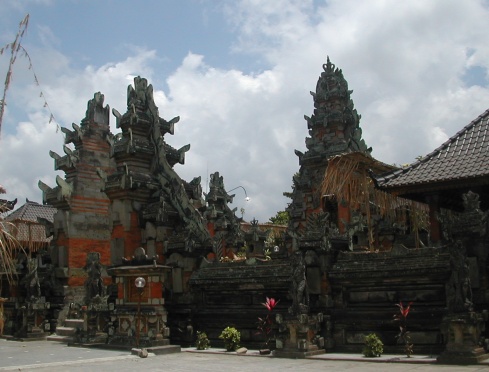BALINESE HINDUSIM
Balinese Hinduism is unlike Hinduism practiced in other parts of the world today. To the outsider, it appears complex and convoluted. Although we have not learned nearly as much as we would like, we have learned a few of the basics of the structure of beliefs and the ubiquitous temples.
Balinese Hinduism combines aspects of Animism, Ancestor Worship, Buddhism, and Hinduism. Some of these beliefs date back more than 4,000 years.
The original Balinese – the Bali Aga – populated Bali around 2500 BC. Their religion was based on Animism and Ancestor Worship. Animism is the belief that inanimate objects and other elements of the natural landscape can possess souls. Those souls can help or hinder human efforts on Earth. Ancestor Worship is the belief that prosperity comes from a living person’s relationship with the dead. Prosperity is something that can only be achieved through intense worship and obtainment of blessings from ancestors.
Around 500 AD, Hindu and Buddhist priests began arriving in Bali on Indian trade ships. Several Javanese Hindu kingdoms conquered Bali between 732 and 1478 AD.
The fundamental doctrine of Hinduism involves the concept of reincarnation – or transferability of the soul –and all living things are believed to be able to take part in reincarnation. After death, the body or form of how an individual is reincarnated is determined by a social caste system based on how ‘badly’ or ‘well’ their behavior was during their most recent life.
There are three primary Balinese Hindu castes: 1) Brahmans or Priests, 2) Kshatriya or Nobles, and 3) Sudra or Commoners. The Balinese caste system further divides the Brahman into the Saiwite Brahman (Brahmana-Siwa) and Buddhist Mahayana Brahmana (Brahmana-Buddha). Also, the Balinese Hindu caste system is not nearly as rigid as its Indian counterpart.
Buddhism was founded by Gautama (the Buddha) in northeastern India around 560 BC. Like Hinduism, the fundamental doctrine of Buddhism involves reincarnation. However, Gautama founded Buddhism primarily as a protest to the Indian caste system. Gautama taught his followers that humans can be liberated from the ceaseless cycle of reincarnation by abandoning desires that create misery in the world and removing spiritual ignorance.
Balinese Hinduism is a unique blend of these four beliefs: Animism, Ancestor Worship, Hinduism, and Buddhism. Consequently, its practice is unique to Bali. Its practice is most apparent, though, in the abundance of shrines and temples throughout Bali. Again, our knowledge is quite superficial, but it is a start for our curious minds.

The home of every Balinese Hindu will have, at minimum, a shrine, and many will have small temples. But all villages will have a temple, and most have three temple sites. Most villages will have a Pura Puseh (temple of origin), Pura Desa (village temple), and Pura Dalem (temple of the dead).
The Pura Puseh is usually located towards the upstream end of the village. This temple is associated with the God Wisnu, and it is dedicated to remembering the founders of the village. Wisnu is also known as ‘the sustainer of life’ because he has the ability to incarnate as an avatar (God-Man), move freely between the heaven of the Gods and the Earth of humans, and he often appears to save the world by realigning it to the divine.
The Pura Desa is usually located in the middle of the village. This temple is associated with the God Brahma, and it is where community councils meet to pray and govern. Brahma is also known as ‘the creator’ because he is a reflection of creative consciousness. Both artistic creativity (a very important part of Balinese villages) and creation itself emerge from this creative consciousness.
The Pura Dalem is usually located towards the downstream end of the village. This temple is associated with the God Siwa, and it may have a graveyard. Siwa is also known as ‘the destroyer’ because his spiritual role is to destroy negativity in the world. Siwa prepares dead people for reincarnation by judging whether or not a person’s karma (actions) has been bad or good.
Temples are usually used for ceremonies, but shrines are visited casually and, possibly, many times each day. Prayers and offerings (canang sari) are made at shrines, and the offerings can also be found anywhere you look in Bali – sidewalks, stores, restaurants, etc. It is bad form to step on these, and they are sometimes so numerous that they can be difficult to avoid. Offerings may include flowers, food, cigarettes, or whatever else one has and wishes to offer. They are intended to please the good spirits and appease the evil ones.
There are a seemingly endless number of other religious figures and practices about which we haven’t a clue, but we found it interesting that this one island – only Bali – practices this unique blend of other religious beliefs. Someday when we have access to an English-language bookstore and time to spare, this will find its way on our reading list. The Balinese are unique in so many ways!
Return to our Bali page.